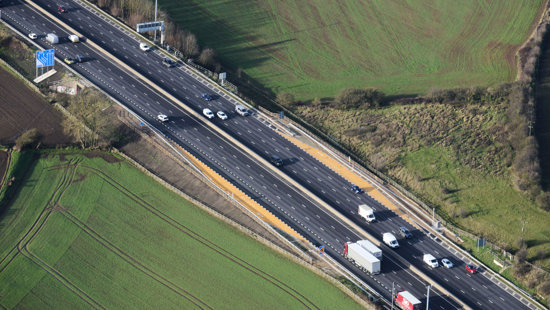National Highways completes programme to install more than 150 additional emergency areas on smart motorways

A nationwide programme to construct and install more than 150 additional emergency areas across the motorway network has been completed.
A nationwide programme to construct and install more than 150 additional emergency areas across the motorway network has been completed.
National Highways began main construction on more emergency areas in June 2023, with the M1 in South Yorkshire being the first to benefit from the £390 million scheme.
Work has been carried out on stretches of the M1, M3, M4, M5, M20, M25 and M27 with the remaining roadworks being removed this week
National Highways chief executive, Nick Harris, said:
“All new emergency areas have now been installed, marking the end of this important safety scheme. Emergency areas provide drivers with more frequent opportunities to pull over should they break down or experience difficulties. The latest analysis continues to show that overall, smart motorways remain our safest roads.”
“I’d like to thank drivers for their patience throughout the work.”
Future of Roads Minister, Lilian Greenwood, said:
“We take road safety seriously, and that’s why I’m pleased to see the installation of more than 150 additional emergency areas on smart motorways across the country, helping to keep people safe.
“We’ve been clear we will not roll out any new smart motorways.”
On motorways that don’t have a permanent hard shoulder, emergency areas offer a place to stop in an emergency if you cannot exit the motorway or stop at a motorway service area.
They are marked by blue signs featuring an orange SOS telephone symbol. Each is coloured orange and is around the same length as a football pitch. They are positioned at regular intervals, providing somewhere safe to stop and have phones linked directly to our control rooms.
This investment in new emergency areas, stopped vehicle detection technology, additional signs and more information about smart motorways online and in an updated Highway Code, is all designed to help road users feel safe and be even safer on our roads.
Important advice and guidance for driving on all types of motorways and what to do in an emergency can be found here.
Notes to Editors
The installation of additional emergency areas makes up part of a commitment to deliver £900 million in further safety improvements on existing smart motorways.
All the actions set out to further improve safety on smart motorways, which can be seen here, are now complete. This includes:
- installing more than 700 additional signs informing drivers of the distance to the next place to stop in an emergency
- upgrading enforcement cameras on smart motorways to enable them to be used to detect vehicles passing under a Red X or entering a lane beyond a Red X
- ensuring radar stopped vehicle detection (SVD) is in place on every all lane running (ALR) motorway
Emergency areas were installed at locations where they could make the most difference and bring benefits to drivers as soon as possible. They are as follows:
South East (51)
• Four on the M20 between junctions 3 and 5 in Kent
• Nine on the M25 between junctions 5 and 7 in Kent - 50mph speed limit to
remain in place for technology testing
• Ten on the M3 between junctions 2 and 4a in Surrey
• Twelve on the M4 between junctions 10 and 12 in Berkshire
• Fourteen on the M25 between junctions 23 and 27 in Hertfordshire - 50mph
speed limit to remain in place for technology testing
• Two on the M27 between junctions 4 and 11 in Hampshire
Midlands (75)
• Five on the M6 between junctions 13 and 15 in Staffordshire (delivered during
main construction in 2022)
• Eight on the M1 between junctions 13 and 16 (delivered during main
construction in 2022)
• Six on the M1 between junctions 23A and 25 in Leicestershire and
Nottinghamshire
• Eighteen on the M1 between junctions 28 and 30 in Derbyshire
• Ten on the M1 between junctions 30 and 31
• Ten on the M5 between junctions 4A and 6 in Worcestershire
• Eighteen on the M1 between junctions 16 and 19 in Northamptonshire and
Leicestershire
North (25)
• Twelve on the M6 between junctions 21a and 26 in Cheshire
• Thirteen on the M1 between junctions 32-35a in South Yorkshire
